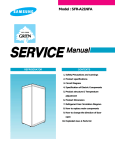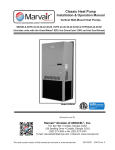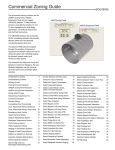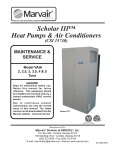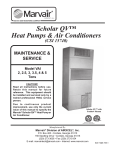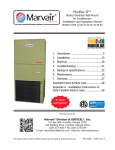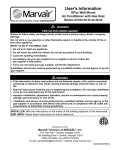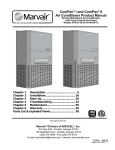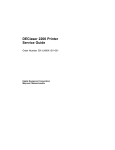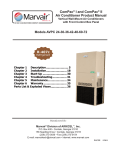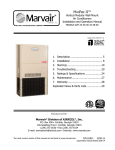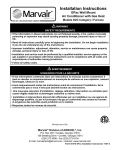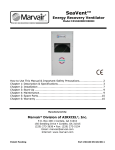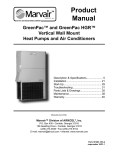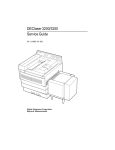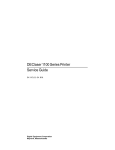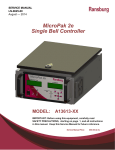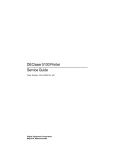Download Marvair HVPA60 Service manual
Transcript
Classic HVPA & HVPSA Heat Pumps MAINTENANCE & SERVICE Models HVPA24-30-36-42-49-60 & HVPSA36-42-49-60 CAUTION!! Read all instructions before use. Retain this manual for future reference. This equipment should be installed and serviced only by a trained professional HVAC service person. Due to continuous product improvement, use only the current issue of this manual. The latest version can be downloaded from the Marvair website - www.marvair.com. Manufactured By: Marvair Division of AIRXCEL®, Inc. ® P.O. Box 400 • Cordele, Georgia 31010 156 Seedling Drive • Cordele, Georgia 31015 (229) 273-3636 • Fax (229) 273-5154 E-mail: [email protected] • Internet: www.marvair.com Classic HVPA & HVPSA M&S 8.09-1 SECTION 15700 HEATING, VENTILATING AND AIR CONDITIONING EQUIPMENT MAINTENANCE & SERVICE MANUAL FOR CLASSICTM HEAT PUMP TABLE OF CONTENTS Chapter 1.1 Description Page General Description ..................................................................3 1.2 Model Identification ..................................................................4 2.1 Start-up Instructions .................................................................5 2.2 Ventilation System Calibration....................................................7 3.1 Electrical ..................................................................................9 4.1 Maintenance ............................................................................9 5.1 Function & Description of Primary Components......................... 10 6.1 Troubleshooting......................................................................13 7.1 Filing a Service/Warranty Claim ...............................................23 8.1 Warranty Statement................................................................24 9.1 Parts List................................................................................25 Classic HVPA & HVPSA M&S 8.09-1 15700 - 2 HVAC Equipment SECTION 15700 HEATING, VENTILATING AND AIR CONDITIONING EQUIPMENT The purpose of this manual is to provide instructions for maintenance and service for the Marvair® Classic™ series of heat pumps. In addition to this manual, there are other pieces of literature available from Marvair. The Product Manual covers the installation of the unit and various accessories and the initial start-up of the unit. An overview of the product line can be found in the Classic Product Data Sheets. The current version of this literature can be found and downloaded from the Marvair website at www.marvair.com. To minimize sound levels within the classroom, certain options should be selected. These options are designated by throughout the guideline. 1.1 GENERAL OPERATION A. Classic™ heat pumps are designed to provide quiet comfort to the classroom. In cooling mode, the compressor will cycle on to provide the cooling required. The system provides cooling, dehumidification and air circulation. In heating mode the compressor (heat pump only) will cycle on to provide the heating required. The system provides heating and air circulation. At lower outdoor temperatures, additional heating capacity may be provided by an optional electric resistance heater. Ventilation air may be provided by the manual or motorized fresh air vent, power vent or GreenWheel® ERV. These ventilation systems operate when there is a call for cooling or heating or independently to provide fresh air. Note that with the manual, motorized fresh air vent and the power vent options, if the compressor is not operating and the indoor blower is running, unconditioned outside air is being introduced into the classroom. The GreenWheel ERV provides tempered outside air. Control systems are either a remote external thermostat, internal thermostat, or a direct digital control interfacing with the building automation system (BAS). Hot Gas Reheat (HGR) Dehumidification (Option). To provide on demand dehumidification, the Classic™ heat pump can have a factory installed hot gas reheat coil to allow dehumidification through continued cooling with discharge air reheated to avoid over cooling the classroom. The operation of the HGR is controlled by a three-way heat reclaim valve. The HGR coil is sized to provide a heating capacity approximately equal to the sensible capacity of the unit When the demand for cooling is satisfied and the humidity controller calls for dehumidification, hot gas is directed to a reheat coil downstream from the evaporator coil to add heat to the dehumidified, chilled air supplied to the classroom. Hot gas reheat is available with motorized fresh air, PowerVent and GreenWheel® ventilation systems. Marvair® recommends that for optimum performance, hot gas reheat be used in conjunction with the GreenWheel® heat recovery ventilator. When used with other ventilation options, hot gas reheat may not maintain satisfactory control of the humidity in the classroom over all outdoor conditions. Classic HVPA & HVPSA M&S 8.09-1 15700 - 3 HVAC Equipment 1.2 MODEL IDENTIFICATION The ClassicTM heat pump identification numbering system is shown below. The model identification number is on the data label. The data label is at the bottom of the of left side panel. IMPORTANT WHEN CLASSIC SYSTEMS ARE INSTALLED, MODEL NUMBER AND SERIAL NUMBERS ARE TO BE RECORDED AND MAINTAINED IN A LOCATION FOR IMMEDIATE ACCESS WHEN REQUESTING FURTHER INFORMATION. Classic HVPA & HVPSA M&S 8.09-1 15700 - 4 HVAC Equipment 2.1 START-UP PROCEDURE Important: If your unit has a crankcase heater be sure that the crankcase heater has been energized for at least 24 hours prior to start-up of the unit. Double check all electrical connections before applying power. Various thermostats can be used to control the heat pump. The thermostat may have a fan switch with an Automatic and On positions, a system switch with Heat, Cool, and Off positions, and an emergency heat position with lights. The spec sheets have detailed description of the various Marvair® thermostats. Since other thermostats or remote control systems may be used, the following procedures should be viewed as guidelines for standard thermostats with system and fan switches. Check-out of Cooling Cycle Procedure: Classic™ Heat Pump 1. Set the fan switch to "Auto" and the system switch to "Off". 2. Move the cooling temperature on the wall thermostat to a point higher than the room temperature. Move the heating temperature to a temperature that is lower than the room temperature. 3. Set the thermostats system switch to "Cool" or "Auto" position. Nothing should operate at this time. 4. Set the time delay in the control box to three minutes. Note that time delay is an option on some Classic™ units and may not be on your heat pump. 5. Remove the cover plate from the thermostat. Slowly lower the thermostat cooling temperature. Once the indoor fan turns on, allow approximately three minutes for the compressor and outdoor fan to start. For units equipped with the low ambient control, note that the outdoor fan may not come on immediately, because it is cycled by refrigerant pressures. Some units have a time delay module which prevents the compressor from restarting immediately after interruption of power. See section 1.5P and 1.5Q for details on the operation of the low ambient control and the time delay. If the unit fails to operate, refer to the troubleshooting information in Chapter 6.1. Classic™ Heat Pump with Economizer 1. Set the fan switch to "Auto" and the system switch to "Off". 2. Set the cooling temperature on the wall thermostat to a point higher than the room temperature. Set the heating temperature to a temperature that is lower than room temperature. 3. Set the thermostat system switch in the "Auto" or "Cool" position. Nothing should operate at this time. Classic HVPA & HVPSA M&S 8.09-1 15700 - 5 HVAC Equipment 4. Set the time delay in the Classic™ Heat Pump with Economizer control box to 3 minutes. Check the enthalpy changeover setting of the H205A or dry bulb sensor, and reset it if needed. Refer to the Owner’s manual for instructions on setting the H205A or dry bulb sensor. 5. Slowly lower the thermostat’s cooling temperature. The indoor fan should operate. Once the indoor fan comes on, allow approximately three minutes for the compressor to start. Note that the outdoor fan may not come on immediately because it is cycled by refrigerant pressures Note: To check the system operation under different ambient conditions, the air temperature and enthalpy sensors must be "tricked". When outdoor ambient conditions are higher than the control setting, a component aerosol cooler may be sprayed directly into the enthalpy sensor to simulate low enthalpy conditions, causing the economizer damper to open. Alternately, when outdoor conditions are lower than the set point, a source of heat such as a hair dryer can be directed on the air temperature sensor to simulate warmer conditions, which will bring on mechanical cooling and start the compressor. If the unit fails to operate, refer to the troubleshooting information in Chapter 6.1. Check-Out of Heating Cycle Procedure: 1. Place the thermostat system switch to "Auto" or "Heat" and the fan to "Auto". 2. Raise the heating temperature to a setting which is higher than the room temperature. The fan and compressor should cycle on after time delay (standard on Classic™ heat pump with economizer and all HVP models, option on all other Classic units) has cycled. 3. Move the system switch to the "Off" position. All functions should stop. The Blower Timed Delay Relay (BTR) keeps the blower running for 90 seconds after the unit shuts off. Note: The damper blade should remain closed during the heating cycle (unless the minimum position potentiometer has been set for constant ventilation). Classic HVPA & HVPSA M&S 8.09-1 15700 - 6 HVAC Equipment 2.2 VENTILATION SYSTEM CALIBRATION Manual Fresh Air System (Configuration N). This is the standard ventilation system in the Classic™ heat pump. Fresh air ventilation by means of a damper can provide up to 15% of rated air flow of outside air. The damper has four positions corresponding to 0, 5, 10 and 15% of rated air flow of outside air. The damper only opens when the indoor fan is operating. Position the screw on the side of the damper hood for the desired air flow. Manual Damper - 0 to 450 cfm of Outside Air, No Pressure Relief (Configuration Y). The amount of fresh air is determined by the position of the collar on the rod. To determine the desired quantity of fresh air: a. With the indoor blower on, measure the quantity of supply air being discharged into the room with a balometer. b. Now measure the quantity of the return air from the room. Subtract the return air from the supply air. The difference is the amount of fresh air. c. Loosen the set screw that holds the collar onto the rod connected to the damper. Move the collar and tighten the set screw. Figure 1. Damper Adjustment Rod Set Screw d. Repeat steps a, b and c until the desired amount of fresh air is being introduced into the room. Important Note: Since Configuration Y does not have internal pressure relief, the fresh air must have a passage to the outside. If a passage is not available, the desired quantity of fresh air cannot be introduced into the room. Motorized Damper - 0 to 450 cfm of Outside Air and Pressure Relief (Configuration B) and the Manual Damper with Pressure Relief (Configuration Z). The settings of the damper require a balometer and a thermometer for measuring internal and external temperatures. a. Measure the total supply air with a balometer. If the supply air is controlled by a manual fan speed controller, make certain that the air flow is in accordance Classic HVPA & HVPSA M&S 8.09-1 15700 - 7 HVAC Equipment with the air flow ((CFM) at various static pressures chart. This chart can be found in the Classic Product Data Sheet or the Installation Manual. This CFM is referred to as "C" in the illustration and equation below. Figure 2. Damper Air Path b. "A" is the quantity of outside air expressed as a percentage of "C". For example, if the supply air is 1,220 CFM and 300 CFM of outside air is required, "A" is 25% (300 CFM/1,220 CFM). Measure the temperature of the outside air. Multiply the temperature by "A". c. "B" is the quantity of return air expressed as a percentage of "C". "A" and "B" must equal 100%. Measure the temperature of the indoor return air. Multiply the temperature of the indoor air by "B". d. Calculate what the Tmix should be with the desired quantity of outside air. Measure the actual temperature of Tmix at the inlet to the supply air blower or at the inlet of the supply air blower. Adjust the damper blade until the measured value of the Tmix equals the calculated or desired value of Tmix. The motorized damper, Configuration B, can be controlled by an optional relay that allows additional external control with a choice of 24, 120 or 240V coils to regulate fresh air ventilation in response to a control located remote from the Classic™ heat pump. 9. Electrical Supply: The power supply must have the appropriate voltage, phase, and ampacity for the Classic HVPA & HVPSA M&S 8.09-1 15700 - 8 HVAC Equipment model selected. Voltage must be maintained above minimum specified values listed below. Refer to the unit data plate for ampacity requirements. Table 1. Voltage Limitations Electrical Rating Designations* A C D Nominal Voltage 208/230 208/230 460 Phase 1 3 3 Minimum Voltage 197 197 414 Maximum Voltage 253 253 506 * Letters refer to model number code designations. 3.1 ELECTRICAL Classic heat pumps and air conditioners are built in a wide variety of configurations and options. The illustrations of the control center and the electrical schematics shown here are typical, but probably are not identical to your units. Please refer to the electrical schematic in each unit for the specific construction of that unit. 4.1 MAINTENANCE Marvair® strongly recommends that the heat pump be serviced a minimum of twice a year – once prior to the heating season and once prior to the cooling season. At this time the filters, evaporator coil, condenser coil, the cabinet, and condensate drains should be serviced as described below. Also at this time, the heat pump should be operated in the cooling and heating cycles as described in Chapter 3, Start-Up. In addition to this seasonal check-out, the unit should be maintained as follows: Air Filter Replace the air filter whenever it is visibly dirty. Indoor Coil If the coil becomes clogged or dirty, it may be cleaned by careful vacuuming or with a commercial evaporator cleaning spray. DO NOT use a solvent containing bleach, acetone, or flammable substances. Turn power OFF before cleaning. Be careful not to wet any of the electrical components. Be sure the unit has dried before restarting. Outdoor Coil Periodically inspect the outdoor coil and the cabinet air reliefs for dirt or obstructions. Remove foreign objects such as leaves, paper, etc. If the coil is dirty, it may be washed off with a commercial solvent intended for this purpose. TURN OFF POWER BEFORE CLEANING! Be sure that all electrical components are thoroughly dry before restoring power. Cabinet The cabinet may be cleaned with a sponge and warm, soapy water or a mild detergent. Do not use bleach, abrasive chemicals or harmful solvents. Classic HVPA & HVPSA M&S 8.09-1 15700 - 9 HVAC Equipment Drains Regularly check the primary and secondary condensate drains. The secondary drain has a stand pipe. An obstruction will force water to dump into the middle of the unit and drain out the sides of the Classic™ Heat Pump, causing discoloration of the side panels. If discoloration is noted, service the drains. If a commercial drain solvent is used, flush out the drain pan and system with plenty of fresh water to prevent corrosion. Lubrication Oiling of the condenser fan motor or the evaporator blower motor is not recommended. 5.1 FUNCTION AND DESCRIPTION OF PRIMARY COMPONENTS A. Compressor. All Classic units use a fully hermetic scroll compressor to minimize sound levels and maximize efficiency. Scroll compressors, like several other types of compressors, will only compress in one rotational direction. The direction of rotation is not an issue with single-phase compressors since they will always start and run in the proper direction. However, three phase compressors will rotate in either direction depending upon phasing of power. Since there is a 50-50 chance of connecting power in such a way as to cause rotation in the reverse direction, it is imperative to confirm that the compressor is rotating in the proper direction at the initial field start-up of the system. Verification of proper rotation is made by observing that the suction pressure drops and the discharge pressure rises when the compressor is energized. An alternate method of verification for self contained system with small critical refrigerant charges, where the installation of gauges may be objectionable, can be made by monitoring the temperature of the refrigerant lines at the compressor. The temperature should rise on the discharge line while the suction line temperature decreases. Reverse rotation also results in a substantially reduced current draw when compared to tabulated values. There is no negative impact on durability caused by operating three phase compressors in the reversed direction for a short duration of time, usually defined as less than one hour. However, after several minutes of operation the compressor's internal protector will trip. The compressor will then cycle on the protector until the phasing is corrected. Reverse operation for longer than one hour may have a negative impact on the bearings. B. Indoor Blower and Motor. The indoor blower assembly is an electronically commutated blower motor and dual blowers. C. Outdoor Air Mover. The outdoor air mover is an axial fan with an asynchronous external rotor motor. D. Indoor/Outdoor Coils. The coils are constructed of lanced, aluminum fins mechanically bonded to rifled, seamless copper tubes. E. Filter Drier - The filter drier performs two functions in the refrigerant circuit. First, Classic HVPA & HVPSA M&S 8.09-1 15700 - 10 HVAC Equipment it removes foreign particulate matter, e.g. dirt, scale, solder particles from the refrigerant to protect the compressor and other components in the refrigerant system with small openings or close tolerances. Second, it absorbs any moisture in the refrigerant with desiccant granules. F. High Pressure Switch and Loss of Charge Switch. These switches render the compressor and outdoor fan motor inoperative whenever the limits of the high or loss of charge switches are exceeded. In the event of high pressure, the ClassicTM unit will turn off and lockout. The high pressure switch opens at 610 psig and resets at 420 psig. The Loss of Charge Switch is designed to guard against the operation of the system in the event of a loss of refrigerant. The loss of charge switch opens at 40 psig and closes at 60 psig. In cold weather the pressure in the refrigerant system is low prior to operation. When the Classic™ unit starts in the heat pump mode during cold weather, low pressure could cause the system to lock out. To guard against nuisance lockouts, the Classic unit will not shut off if the Loss of Charge Switch (LPS) comes on during the first eight minutes of operation. In other words, the compressor will start and operate for eight minutes even with the LPS switch off. The high and low pressure switches are resettable at the wall thermostat or by turning power off and then on to the ClassicTM unit. G. Metering Devices. The Classic uses a thermal expansion valve on the indoor (cooling) circuit and a fixed orifice on the outdoor (heating) circuit. H. Reversing Valve. The reversing valve reverses the refrigerant’s direction of flow in a heat pump, allowing the heat pump to switch from cooling to heating or heating to cooling. I. Exhaust Air Ventilation Blower is used to exhaust classroom in the GreenWheel ERV ventilation option. The blower can exhaust up to 450 CFM of air from the classroom. In the standard configuration, both the exhaust and the intake ventilation blowers are controlled by a single speed controller. This speed controller permits the motor speed to be adjusted for the correct cfm of ventilation air. As an option, a second motor controller may be factory installed to allow independent control of the intake and exhaust air blowers. This allows pressurization of the classroom. All ventilation options have an intake air blower. J. Intake Ventilation Air Blower (GreenWheel ERV only) is used to introduce outside air into the classroom. K. Electric Resistance Heat. The heaters are available in various sizes (kW) for operation on 208/230v. 1Ø, 208/230 v. 3Ø, and 460v, 3Ø. The model number of the heat pump indicates the power supply and kW. L. Electric Resistance Heat Controls. Included with the electric heat assembly are temperature switches designed to turn power off to the heaters if the temperature is too high. There are two types of temperature switches. The first is an auto-reset type that turns power off to the heater if it senses a temperature of 145°F. When the temperature drops to approximately 105°F, power is restored to the heaters. This auto-reset switch is in the low voltage circuit. Classic HVPA & HVPSA M&S 8.09-1 15700 - 11 HVAC Equipment The second type of switch is a one time limit switch. If it senses a temperature of 300ºF, power is turned off to the elements. This switch does NOT reset when the temperature drops and must be replaced when it activates. The number and location of both switches is determined by the power supply and the kW of the heaters. M. Ventilation Blower Fan Speed Control. Factory setting for the indoor blower speed is full speed. If a lower speed setting is required, the blower motor speed control may be adjusted with a slotted screwdriver rotating the speed control as shown in Figure 3. Reference unit label for minimum required air flow settings for specific unit model. Figure 3. Ventilation Blower Speed Control Adjustment Instructions SERIES 706 VARI-SPEED MOTOR CONTROL LO HI N. Standard Ventilation Control. The GreenWheel® ERV ventilation option is equipped with a fresh air fan speed control. The fresh air fan speed control operates both the ventilation intake and exhaust blowers together. The GreenWheel® ERV ventilation option can be equipped with an exhaust fan air speed control, which controls the ventilation exhaust blower independently of the fresh air intake blower. Demand Control Ventilation. A field or factory installed carbon dioxide sensor controls the ventilation damper and only opens the damper when CO2 levels exceed a specified level. Demand control ventilation saves energy and utility costs by ventilating the classroom based upon occupancy. Note: Not available on manual fresh air damper (“B”) configuration. O. Outdoor Thermostat. Factory set at 40°F, this thermostat determines the outdoor temperature at which the supplemental electric heat turns on. This may be field adjusted to the desired temperature setting by rotating the adjustment knob. P. Low Ambient Control (Standard on units with economizers, optional on all other units.) The low ambient control permits mechanical cooling when outdoor ambient temperatures are low. The control uses a reverse-acting high pressure switch to cycle the condenser fan motor according to liquid refrigerant pressure conditions. Switch closure and fan operation occurs when the pressure reaches 400 PSIG. The switch opens again when the refrigerant pressure falls to 245 PSIG. Therefore, the outdoor Classic HVPA & HVPSA M&S 8.09-1 15700 - 12 HVAC Equipment fan always starts after the compressor, and it will cycle frequently during normal operation at low outdoor conditions. Q. Compressor Time Delay. The time delay module (delay on make) prevents the compressor from restarting immediately after interruption of power. The delay interval, which is adjustable from .2 to 8 minutes, protects the compressor by allowing internal refrigerant pressures to equalize. The time delay does not effect the electric heat circuit. 6.1 TROUBLESHOOTING In diagnosing common faults in the heat pump system, develop a logical thought pattern as used by experienced technicians. The charts which follow are not intended to be an answer to all problems but only to guide the technician’s thinking. Through a series of yes and no answers, follow the logical path to a likely conclusion. A novice technician should use these charts like a road map. Remember that the chart should clarify a logical path to the problem’s solutions. Electrical Checks Flow Chart Unit Running? NO Thermostat Problem? YES - Repair and Recheck YES NO Transformer Problem? NO YES - Repair and Recheck Voltage on Compressor Side of Contactor? YES NO Run Capacitor Voltage on Line Side of Contactor? NO Compressor Internal YES Overload Open Compressor Winding Circuit Breakers or Compressor Contactor Open Fuses Open High Pressure Cut-Out Unit Wiring and YES Connections Low Pressure Cut-Out Compressor Winding Grounded Compressor Time Outdoor Fan Motor Grounded Delay Grounded Capacitor Unit Wiring and Connections Replace Fuses or Reset Breakers and Recheck System Classic HVPA & HVPSA M&S 8.09-1 15700 - 13 Go to Mechanical Check for Cooling or Heating HVAC Equipment Cooling Mechanical Checks Flow Chart Unit Running? High Head Pressure Dirty Outdoor Filter Inoperative Outdoor Fan Overcharge Recirculation of Outdoor Air Non-condensibles Higher than Ambient Air Entering Outdoor Coil Wrong Outdoor Fan Rotation YES Pressure Problems? Low Head Pressure Low on Charge Low Ambient Temperature Inoperative Compressor Valves Outdoor Check Valve Closed Restricted Indoor Metering Device Restricted Filter Drier Reversing Valve Failure NO Low Suction Pressure Dirty Filters Dirty Indoor Coil Inadequate Indoor Air Flow Inoperative Indoor Blower Low on Charge Restricted Indoor Metering Device Go to Electrical Checks Flow Chart Restriction in System Recirculation of Indoor Air Wrong Indoor Blower Rotation Inadequate Ducts Outdoor Check Valve Closed Restricted Filter Drier Classic HVPA & HVPSA M&S 8.09-1 15700 - 14 HVAC Equipment Heating Mechanical Checks Flow Chart Unit Running? High Head Pressure Dirty Filters Dirty Indoor Coil Inoperative Indoor Blower Overcharge Inadequate Indoor Air Flow Non-condensibles Wrong Indoor Blower Rotation Inadequate Ducts YES Pressure Problems? Low Head Pressure Low on Charge Low Indoor Temperature Closed Indoor Check Valve Inoperative Compressor Valves Restricted Outdoor Metering Device Restricted Filter Drier Reversing Valve Failure NO Low Suction Pressure Dirty Outdoor Coil Inadequate Air Flow Over Outdoor Coil Inoperative OD Fan Low on Charge Go to Electrical Checks Flow Chart Restricted Outdoor Metering Device Restriction in System Closed Indoor Check Valve Recirculation of Outdoor Air Restricted Filter Drier Defrost Mechanical Checks Flow Chart No Defrost Defrost System Incomplete Defrost Reversing Valve Stuck Poor Sensor Location No Defrost Timer Control Power Failed Defrost Control Wrong Defrost Control Timer Setting Failed Defrost Relay (doesn’t stop O.D. Fan) Thermostat Satisfies During Defrost Failed Defrost Relay Loose Default Sensor Classic HVPA & HVPSA M&S 8.09-1 15700 - 15 Excessive Defrost Wrong Defrost Control Timer Setting Poor Sensor Location Low System Charge Wind Affecting in Defrost HVAC Equipment Subcooling Calculation 1. Measure the liquid pressure at the liquid line service valve. 2. Convert the liquid line pressure to saturated temperature. See tables below. 3. Measure the liquid line temperature at the liquid line service valve. 4. Compare the liquid line temperature to the saturated temperature. 5. The difference between saturated temperature and liquid line temperature is the subcooling. Subcooling normal range 12° to 20°. Superheat Calculation 1. Measure the suction pressure at the suction line service valve. 2. Convert the suction line pressure to saturated temperature. See tables below. 3. Measure the suction line temperature approximately 6” to 8” from the compressor. 4. Compare the suction line temperature to the saturated temperature. 5. The difference between saturated temperature and suction line temperature is the superheat. Superheat normal range 12° to 18° Temperature Pressure Chart Temp. (°F) -40 -35 -30 -25 -20 -15 -10 -5 0 5 10 15 20 R-22 PSIG 0.5 2.6 4.9 7.4 10.1 13.2 16.5 20.0 23.9 28.2 32.8 37.7 43.0 R-410A PSIG 11.0 14.2 17.8 21.8 26.1 30.8 35.9 41.5 47.5 54.1 61.2 68.8 77.1 Classic HVPA & HVPSA M&S 8.09-1 Temp. (°F) 25 30 35 40 45 50 55 60 65 70 75 80 85 R-22 PSIG 48.7 54.9 61.5 68.5 76.0 84.0 92.5 101.6 111.2 121.4 132.2 143.6 155.7 15700 - 16 R-410A PSIG 86.0 95.5 105.7 116.6 128.3 140.8 154.1 168.2 183.2 199.2 216.1 234.0 253.0 Temp. (°F) 90 95 100 105 110 115 120 125 130 135 140 145 150 R-22 PSIG 168.4 181.8 195.9 210.7 226.3 242.7 259.9 277.9 296.8 316.5 337.2 258.8 381.5 R-410A PSIG 273.0 294.1 316.4 339.9 364.6 390.5 417.7 446.3 476.3 507.6 540.5 574.8 610.6 HVAC Equipment Troubleshooting Chart WARNING DISCONNECT ALL POWER TO UNIT BEFORE SERVICING. CONTACTOR MAY BREAK ONLY ONE SIDE. FAILURE TO SHUT OFF POWER CAN CAUSE ELECTRICAL SHOCK RESULTING IN PERSONAL INJURY OR DEATH. Problem/Symptom Unit will not run. Likely Cause(s) 1. Power off or loose electrical connection. 2. Thermostat out of calibration Correction 1. Check for correct voltage at unit disconnect. Check for correct voltage at contactor in unit. 2. Reset. - set too high. Outdoor fan runs, compressor doesn’t. 3. Defective contactor. 3. Check for 24 volts at contactor coil - 4. 5. 6. 7. 1. 2. 4. 5. 6. 7. 1. 2. Blown fuse/tripped breaker. Transformer defective. High pressure control open. Low pressure control open. Run capacitor defective Loose connection. or open motor winding, open internal overload. 4. Low voltage condition. Replace. Check for correct voltage at compressor - check and tighten all connections. 3. Wait at least 2 hours for overload to reset. If still open, replace the compressor. 4. Add start kit components. 1. Improperly sized unit. 2. Improper indoor air flow. 1. Recalculate load. 2. Check - should be approximately 400 CFM 3. Incorrect refrigerant charge. 4. Air, non-condensibles or mois- 3. Charge per procedure. 4. Recover refrigerant, evacuate and 3. Compressor stuck, grounded Insufficient cooling. replace if contacts are open. Replace fuses/reset breaker. Check wiring - replace transformer. Reset. Reset. per ton. ture in system. recharge, add filter drier. Compressor short cycles. 1. Incorrect voltage. Registers sweat. 1. At compressor terminals, voltage must be 2. Defective overload protector. 3. Refrigerant undercharging. 1. Low indoor air flow. ±10% of nameplate marking when unit is operating. 2. Replace - check for correct voltage. 3. Add refrigerant. 1. Increase speed of blower or reduce restriction - replace air filter. High head - low vapor pressures. High head - high or normal vapor pressures - cooling mode. 1. Restriction in liquid line, expansion device or filter drier. 2. Flow check piston size too small. 3. Incorrect capillary tubes. 1. 2. 3. 4. Dirty outdoor coil. Refrigerant overcharge. Outdoor fan not running. Air or non-condensibles in system. Classic HVPA & HVPSA M&S 8.09-1 15700 - 17 1. Remove or replace defective 2. 3. 1. 2. 3. 4. component. Change to correct size piston. Change assembly coil. Clean coil. Correct system charge. Repair or replace. Recover refrigerant, evacuate and recharge. HVAC Equipment Troubleshooting Chart (cont’d) Problem/Symptom Low head - high vapor pressures. Low vapor - cool compressor - iced indoor coil. Likely Cause(s) 1. Flow check piston size too large. 2. Defective compressor valves. 3. Incorrect capillary tubes. 1. Low indoor air flow. 2. Operating below 55°F outdoors. 3. Moisture in system. High vapor pressure. Fluctuating head and vapor pressures.. 1. 2. 1. 2. Excessive load. Defective compressor. TXV hunting. Air or non-condensibles in system. Correction 1. Change to correct size piston. Replace compressor. 2. Replace coil assembly. 1. Increase speed of blower or reduce restriction - replace air filter. 2. Add low ambient kit. 3. Recover refrigerant - evacuate and recharge - add filter drier. 1. Recheck load calculation. 2. Replace. 1. Check TXV bulb clamp - check air distribution on coil - replace TXV. 2. Recover refrigerant, evacuate and recharge. Gurgle or pulsing noise at expansion device or liquid line. 1. Air or non-condensibles in system. 1. Recover refrigerant, evacuate and recharge. Service Analyzer Charts Problem/Symptom High superheat. Compressor Overheating Correction Likely Cause(s) 1. Low charge. 1. Check system charge. 2. Faulty metering device. 2. Restricted cap tube, TXV. 3. High internal load. 4. Restriction in liquid line. 5. Low head pressure. Low voltage. 1. Loose wire connections. 2. Dirty or pitted compressor Power element superheat adjustment. Foreign matter stopping flow. 3. Hot air (attic) entering room. Heat source on; miswired or faulty control. 4. Drier plugged. Line kinked. 5. Low charge. Operating in low ambient temperatures. 1. Check wiring. 2. Replace contactor. contactor contacts. 3. Power company problem, transformer. High voltage. continues. 4. Undersized wire feeding unit. 1. Power company problem. Classic HVPA & HVPSA M&S 8.09-1 3. Have problem corrected before diagnosis 15700 - 18 4. Correct and complete diagnosis. 1. Have problem corrected. HVAC Equipment Problem/Symptom High head pressure. Compressor Overheating (cont’d) Correction Likely Cause(s) 1. Overcharge. 1. Check system charge. 2. Dirty heat pump coil. 2. Clean coil. 3. Faulty or wrong size heat pump 3. Replace fan motor. fan motor. 4. Faulty outdoor blower. 5. Recirculation of air. 6. Additional heat source. 7. Non-condensibles 4. Replace blower. Replace with correct rotation motor. 5. Correct installation. 6. Check for recirculating from other equipment. 7. Recover refrigerant, evacuate and recharge system. Short cycling of compressor. Faulty compressor valves. 1. Faulty pressure control. 2. Loose wiring. 3. Thermostat. 1. Replace pressure control. 2. Check unit wiring. 3. Located in supply air stream. Differential setting too close. Customer mis-use. Internal foreign matter. Power element failure. Valve too small. Distributor tube/tubes restricted. Restricted with foreign matter. Kinked. I.D. reduced from previous compressor failure. Check system charge. Dirty coil. Dirty filter. Duct too small or restricted. Replace. Replace compressor. 4. TXV. 4. 5. Capillary Tube. 5. 6. Low charge. 7. Low evaporator air flow. 6. 7. 8. Faulty run capacitor. 9. Faulty internal overload. 1. Fast equalization/low pressure 8. 9. 1. Replace compressor and examine system to locate reason. difference. Electrical Voltage present on load side of compressor contactor and compressor won’t run. 1. Run capacitor. 2. Internal overload. 3. Compressor windings. 1. Check with ohmmeter. 2. Allow time to reset. 3. Check for current ohms. Voltage present on line side of compressor contactor only. 1. Thermostat. 1. Check for control voltage to 2. Compressor control circuit. 2. High pressure switch. compressor-contactor coil. Low pressure switch. Compressor turned off/on control or interlock. Classic HVPA & HVPSA M&S 8.09-1 15700 - 19 HVAC Equipment Problem/Symptom No voltage on line side of compressor contactor. Improper voltage. Moisture. Electrical (cont’d) Likely Cause(s) 1. Blown fuses or tripped circuit breaker. 2. Improper wiring. 1. High voltage. 2. Low voltage. 3. Single phasing (3 phase). Contamination 1. Poor evacuation on installation or Correction 1. Check for short in wiring or unit. 2. Recheck wiring diagram. 1. Power supply problem. 2. Power supply problem. Wiring undersized. Loose connections. 3. Check incoming power and fusing. during service. High head pressure. Unusual head and suction readings. 1. Non-condensibles air. 1. Wrong refrigerant. Foreign matter copper fittings. 1. Copper tubing cuttings. Copper oxide. 1. Dirty copper piping. 1. Nitrogen not used. 1. Adding flux before seating copper Welding scale. Soldering flux. 1. In each case, the cure is the same, recover refrigerant. Add filter drier, evacuate and recharge. part way. Excess soft solder. Low suction pressure. Cold, noisy compressor - slugging. Noisy compressor. Cold, sweating compressor. Low load. Short cycling of compressor. 1. Wrong solder material. Loss of Lubrication 1. Low charge. 1. Check system charge. 2. Refrigerant leaks. 2. Repair and recharge. 1. Dilution of oil with refrigerant. 1. Observe piping guidelines. 1. Migration. 1. Flooding. 1. Check crankcase heater. 1. Check system charge. 1. Reduced air flow. 2. Thermostat setting. 1. Dirty filter. 1. Faulty pressure control. 2. Loose wiring. 3. Thermostat. 1. Replace control. 2. Check all control wires. 3. In supply air stream, out of Dirty coil. Wrong duct size. Restricted duct. 2. Advise customer. calibration. Customer misuse. Flooding Poor system control using a TXV. 1. 2. 3. 4. Loose sensing bulb. Bulb in wrong position. Wrong size TXV. Improper superheater setting. Classic HVPA & HVPSA M&S 8.09-1 15700 - 20 1. 2. 3. 4. Secure the bulb and insulate. Relocate bulb. Use correct replacement. Adjust, if possible, replace if not. HVAC Equipment Problem/Symptom Poor system control using capillary tubes. Flooding (cont’d) Likely Cause(s) 1. Overcharge. 2. High head pressures. Correction 1. Check system charge. 2. Dirty heat pump. Restricted air flow. Recirculation of air. 3. Adjust air flow to 400 CFM/Ton. High superheat, low suction pressure. 3. Evaporator air flow too low. Thermostatic Expansion Valves 1. Moisture freezing and blocking 1. Recover charge, install filter drier, evacuate system, recharge. valve. 2. Dirt or foreign material blocking 2. Recover charge, install filter-drier, evacuate system, recharge. valve. 3. Low refrigerant charge. 4. Vapor bubbles in liquid line. 3. Correct the charge. 4. Remove restriction in liquid line. 5. Misapplication of internally equal- Correct the refrigerant charge. Remove non-condensible gases. 5. Use correct TXV. ized valve. 6. Plugged external equalizer line. 6. Remove external equalizer line 7. Undersized TXV. 8. Loss of charge from power head 7. Replace with correct valve. 8. Replace power head or complete TXV. restriction. sensing bulb. 9. Charge migration from sensing bulb to power head (warm power head with warm, wet cloth. Does valve operate correctly now?) 10. Improper superheat adjustment (only applicable to TXV with adjustable superheat settings). Valve feeds too much refrigerant, with low superheat and higher than normal suction pressure. 1. Moisture causing valve to stick 2. 3. 4. 5. open. Dirt or foreign material causing valve to stick open. TXV seat leak (a gurgling or hissing sound is heard at the TXV during the off cycle, if this is the cause). Not applicable to bleed port valves. Oversized TXV. Incorrect sensing bulb location. 6. Low superheat adjustment (only applicable to TXV with adjustable superheat setting). 7. Incorrectly installed or restricted external equalizer line. Classic HVPA & HVPSA M&S 8.09-1 15700 - 21 9. Ensure TXV is warmer than sensing bulb. 10. Adjust superheat setting counterclockwise. 1. Recover refrigerant, replace filter drier, evacuate system and then recharge. 2. Recover refrigerant, replace filter drier, evacuate system and recharge. 3. Replace the TXV. 4. Install correct TXV. 5. Install bulb with two mounting straps, in 2:00 or 4:00 position on suction line, with insulation. 6. Turn superheat adjustment clockwise. 7. Remove restriction, or relocate external equalizer. HVAC Equipment Problem/Symptom Compressor flood back upon start-up. Superheat is low to normal with low suction pressure. Thermostatic Expansion Valves (cont’d) Correction Likely Cause(s) 1. Any of the causes listed under 1. Any of the solutions listed under symptoms of problem 2. 1. Unequal evaporator circuit loading. 2. Low load or air flow entering evaporator coil. solutions of problem 2. 1. Ensure air flow is equally distributed through evaporator. Ensure proper piston. Check for blocked distributor tubes. 2. Ensure blower is moving proper air CFM. Remove/correct any air flow restriction. Superheat and suction pressure fluctuate (valve is hunting) 1. Expansion valve is oversized. 2. Sensing bulb is affected by liq- 1. Install correct TXV. 2. Relocate sensing bulb in another position Valve does not regulate at all. 1. External equalizer line not con- 1. Connect equalizer line in proper location, nected or line plugged in. 2. Sensing bulb lost its operating charge. 3. Valve body damaged during soldering or by improper installation. or remove any blockage. 2. Replace TXV. 3. Replace TXV. around the circumference of the suction uid refrigerant or refrigerant oil flowing through suction line. line. 3. Unequal refrigerant flow through 3. Ensure proper distributor piston is evaporator circuits. inserted. Ensure sensing bulb is located properly. Check for block distributor tubes. 4. Improper superheat adjust4. Replace TXV or adjust superheat. ment (only possible with TXV having superheat adjustment. 5. Moisture freezing and partially 5. Recover refrigerant, change filter drier, blocking TXV. evacuate system and recharge. Classic HVPA & HVPSA M&S 8.09-1 15700 - 22 HVAC Equipment 7.1 PROCEDURE FOR FILING A WARRANTY CLAIM 156 Seedling Drive • Cordele, GA 31015 • P.O. Box 400 • Cordele, GA 31010-0400 Phone 800-841-7854 • 229-273-3636 • Fax 229-276-1479 • Svc Pager 800-204-8210 MARVAIR SERVICE REQUEST / PURCHASE ORDER FOR SERVICE DATE RECEIVED TIME NOTIFIED DATE DISPATCHED Marvair Use TIME DISPATCHED Marvair Use CUSTOMER PO# MARVAIR SERVICE PO # Marvair Use Person requesting service: Company requesting service: Phone #: Fax #: Site Information: Point of Contact: Company: Phone: Alt. Name & Phone: Site Address: Site# / Bldg# / Name: City: ST. Zip: Site Access Information: Equipment Repair Information: MODEL # SERIAL NUMBER NATURE OF PROBLEM Marvair Use - Service Company Information: Service Company: Contact: Phone #: Fax: Address: Labor Rate: City: ST. Zip: If included here, please review and sign our service centers Warranty Policy Information/Agreement then fax back to 229-2735154. Invoices will be paid in accordance with Labor Allowance Guidelines included with this PO. Failure to follow these guidelines and labor allowances may result in delayed payment. All over time work must be approved in advance. All times allowed for entry into the refrigerant circuit include evacuation, recharge, refrigerant and drier change. Service centers are required to notify Marvair if site travel will exceed 1 hour each way – additional travel time must be approved in advance. Detailed invoices or service tech call sheet/work orders are required to be submitted with invoices for payment. Service Tech’s should document work in detail and include/verify model(s) and serial number(s) of the equipment and include Marvair’s PO on all documentation. Marvair will provide contractors with warranty replacement parts for service calls please contact us at 800841-7854. Classic HVPA & HVPSA M&S 8.09-1 15700 - 23 HVAC Equipment 8.1 WARRANTY If any part of your Marvair® Air Conditioner, Heat Pump or Unit Ventilator fails because of a manufacturing defect within fifteen months from the date of original shipment from Marvair or within twelve months from the date of original start-up, whichever is the earlier date, Marvair will furnish without charge, EXW Cordele, Georgia, the required replacement part. Any transportation, related service labor, diagnosis calls, filter, driers, and refrigerant are not included. The owner must provide proof of the date of the original start-up. The owner’s registration card filed with Marvair, the contractor’s invoice, the certificate of occupancy or similar document are examples of proof of the date of the original start-up. In addition, if the hermetic compressor fails because of a manufacturing defect within sixty months from the date of original shipment from Marvair®, Marvair will furnish without charge, EXW Cordele, Georgia, the required replacement part. Any related service labor, diagnosis calls, filter, driers and refrigerant are not included. Marvair will pay for non-priority shipping costs of the compressor during the first twelve months of the warranty period. After the first twelve months of the warranty period, all costs of shipment and risk of loss during the shipment of the compressor shall be the responsibility of the owner. The owner of the product may ship the allegedly defective or malfunctioning product or part to Marvair®, at such owner’s expense, and Marvair will diagnose the defect and, if the defect is covered under this warranty, Marvair will honor its warranty and furnish the required replacement part. All costs for shipment and risk of loss during shipment of the product to Marvair and back to the owner shall be the responsibility and liability of the owner. Upon written request by an owner, Marvair may arrange for remote diagnosis of the allegedly defective or malfunctioning product or part but all costs for transportation, lodging and related expenses with regard to such diagnostic services shall be the responsibility and liability of the owner. An owner requesting performance under this Warranty shall provide reasonable access to the allegedly defective or malfunctioning product or part to Marvair® and its authorized agents and employees. This warranty applies only to products purchased and retained for use within the U.S.A., Canada, and Mexico. This warranty does not cover damage caused by improper installation, misuse of equipment or negligent servicing. THIS WARRANTY CONSTITUTES THE EXCLUSIVE REMEDY OF ANY PURCHASER OF A MARVAIR® HEAT PUMP OR AIR CONDITIONER AND IS IN LIEU OF ALL OTHER WARRANTIES, EXPRESSED OR IMPLIED, INCLUDING, WITHOUT LIMITATION, ANY IMPLIED WARRANTY OF MERCHANTABILITY OR FITNESS FOR USE, TO THE FULLEST EXTENT PERMITTED BY LAW. IN NO EVENT SHALL ANY IMPLIED WARRANTY OF MERCHANTABILITY OR FITNESS FOR USE EXCEED THE TERMS OF THE APPLICABLE WARRANTY STATED ABOVE AND MARVAIR SHALL HAVE NO OTHER OBLIGATION OR LIABILITY. IN NO EVENT SHALL MARVAIR BE LIABLE FOR INCIDENTAL OR CONSEQUENTIAL DAMAGES OR MONETARY DAMAGES. THIS WARRANTY GIVES YOU SPECIFIC LEGAL RIGHTS, AND YOU MAY ALSO HAVE OTHER RIGHTS WHICH VARY FROM STATE-TO-STATE. Some states do not allow limitations or exclusions, so the above limitations and exclusions may not apply to you. Classic HVPA & HVPSA M&S 8.09-1 15700 - 24 HVAC Equipment 9.1 PARTS LIST Classic™ Heat Pump Parts List - Models HVPA PARTS Compressor, Scroll Capacitor, Scroll Compressor ufd/volts HVPA24HP HVPA30HP HVPA36HP HVPA42HP HVPA49HP HVPA60HP HPA1 10333 (K5) 10298 10349 10352 10310 10313 HPF2 10384 10378 10385 10388 10388 10389 HPC3 10327 10299 10350 10353 10311 10314 HPD4 10328 10300 10351 10354 10312 10315 50280 50315 50321 50321 50327 50315 (2) 35 / 370 40 / 370 45 / 370 45 / 370 70 / 440 40 / 370 50315 50323 50323 50159 50159 50320 (2) HPA Capacitor, Scroll Compressor ufd/volts HPF 40 / 370 60 / 370 60 / 370 80 / 370 80 / 370 40 / 440 HPA/HPF 19012 19012 19012 19012 19012 19012 HPC/HPD 19013 19013 19013 19013 19013 19013 Sound Blanket, Compressor 20052 20052 20052 20054 20054 20054 Indoor Coil 60385 16 x 33 60360 16 x 36 60360 16 x 36 60340 18 x 36 60027 24 x 36.5 60027 24 x 36.5 Compressor Plug/Cord, 80” Long Thermal Expansion/Check Valve P/N 20362 20362 20366 20366 20337 20337 Feeders See Below See Below See Below See Below 4/D209/20” 4/D209/20” P/N 20367 20367 20367 20368 Included Included Feeders 20” 20” 20” 20” 20” 20” Nozzle J2 J2 J2 J3 E3 E3 Coil, Evaporator, Reheat (G Option5) 60051 60148 60148 60148 60133 60133 Valve, 3-Way Diverting (G Option) 20257 20257 20257 20257 20257 20257 Coil, Solenoid Valve (G Option) 20028 20028 20028 20028 20028 20028 Outdoor Coil 60380 60370 60370 60355 60072 (2) 60072 (2) 20119 2 x 3/16” x 20” 20119 2 x 3/16” x 20” 20119 2 x 3/16” x 20” 20121 4 x 3/16” x 20” 20338 (2) 6 x 3/16” x 32” 20348 (2) 6 x 3/16” x 32” 20082 (2) Distributor Assembly Distributor, Outdoor, Heating P/N 20103 20097 20064 20082 20083 (Inc.) Size 0.045 0.049 0.053 0.057 0.055 0.057 Indoor Motor, Double Shafted, 240 Volt, ECM 40087 40081 40081 40081 40090 40090 Blower, L.H. 30050 30090 30090 30090 30090 30090 Blower, R.H. 30055 30092 30092 30092 30092 30092 9-7T DD 10-8 DD 10-8 DD 10-8 DD 10-8 DD 10-8 DD Orifice, Outdoor, Heating Blower Wheel / Housing Digital Control Unit 70363 70363 70363 70363 70363 70363 Cable Assembly 01511 01511 01511 01511 01511 01511 Power Cable Assembly 01512 01512 01512 01512 01512 01512 Outdoor Motor 40096 40098 40098 40098 40051 40051 1/4 1075 1/3 825 1/3 825 1/3 825 1/2 825 1/2 825 50350 50240 50240 50240 50360 50360 30115 30135 30135 30135 30149 30149 T2004-22 T2404-20 T2404-20 T2404-20 T2404-34 T2404-34 HP/RPM Capacitor, Outdoor Fan Blade Reversing Valve, RV 20135B 20135B 20135B 20135B 20258A 20258A Solenoid Coil, Reversing Valve 50225B 50225B 50225B 50225B 50225A 50225A Filter Drier 70388 70388 70388 70388 70428 70428 High Pressure Control (610 Open, 420 Close) 70343 70343 70343 70343 70343 70343 Loss of Charge Switch (40 Open, 60 Close) 70342 70342 70342 70342 70342 70342 Accumulator (Orifice) 70320 (.040) 70330 (.040) 70330 (.040) 70330 (.040) 70340 (.055) 70340 (.055) Defrost Control (DFC) 20173 20173 20173 20173 20173 20173 Motor, Economizer (EPA) 40101 40101 40101 40101 40101 40101 Enthalpy Control, ) 70230 70230 70230 70230 70230 70230 Mixed Air Relay (MAR) 50164 50164 50164 50164 50164 50164 Mixed Air Sensor (MAS) 70229 70229 70229 70229 70229 70229 GreenWheel Blower, Flanged, 400 CFM 50780 (2) 50780 (2) 50780 (2) 50780 (2) 50780 (2) 50780 (2) Capacitor, 4 ufd @ 370 Volts, 50256 (2) 50256 (2) 50256 (2) 50256 (2) 50256 (2) 50256 (2) 01226 01226 01226 01226 01226 01226 Motor, GreenWheel Drive 40007 40007 40007 40007 40007 40007 Capacitor, 2 ufd @ 370 Volts 50326 50326 50326 50326 50326 50326 Fan Speed Controller (230 Volt) 70049 70049 70049 70049 70049 70049 Belting, 3/16” Round Urethane P/80390 P/80390 P/80390 P/80390 P/80390 P/80390 Energy Recovery Wheel (continued on following page) Classic HVPA & HVPSA M&S 8.09-1 15700 - 25 HVAC Equipment HVPA24HP HVPA30HP HVPA36HP HVPA42HP HVPA49HP Contactor, Compressor, 30 Amp PARTS HPA 50020 50020 50020 50020 n/a n/a Contactor, Compressor, 40 Amp HPA n/a n/a n/a n/a 50030 50030 Contactor, Compressor, 30 Amp HPC/HPD 50040 50040 50040 50040 50040 50040 92030 92030 92030 92030 92030 92030 Standard 50419 50419 50419 50419 50419 50419 B-Damper6 50420 50420 50420 50420 50420 50420 Actuator, Motor, B-Damper 40107 40107 40107 40107 40107 40107 Lockout Relay (LOR) 50214 50214 50214 50214 50214 50214 Clip for Low Vibration 01257 01257 01257 01257 01257 01257 Relay, Defrost (DFR) 50200 50200 50200 50200 50200 50200 Relay, Heat/Cool, DPDT, 24 Volt 50420 50420 50420 50420 50420 50420 Relay, S-Circuit (SR) 50164 50164 50164 50164 50164 50164 Control Board, Heat Pump, Relay, Fan Blower Control (BTR) Relay, B-Damper HVPA60HP Relay, Outdoor Fan Motor (OFR) HPD 50205 50205 50205 50205 50205 50205 Relay, Heat/Blower (HBR) HPD 50205 50205 50205 50205 50205 50205 Sensor, Open 56 F, Close 28 F 50102 50102 50102 50102 50102 50102 Resistor, 4.7K Ohm, 1/2 Watt, 5% Tolerance 50293 50293 50293 50293 50293 50293 Relay, DPST 50205 50205 50205 50205 50205 50205 Controller, PLC, 70275 70275 70275 70275 70275 70275 P/50182 P/50182 P/50182 P/50182 P/50182 P/50182 50199 50199 50199 50199 50199 50199 Transformer (460 to 230 Volts), 50147 1.5 KVA 50147 1.5 KVA 50147 1.5 KVA 50147 1.5 KVA P/50007 2.0 KVA P/50007 2.0 KVA Transformer (460 to 230 Volts), GreenWheel P/50007 2.0 KVA P/50007 2.0 KVA P/50007 2.0 KVA P/50007 2.0 KVA P/50008 3.0 KVA P/50008 3.0 KVA Contactor, Heat, 2 Pole, 30A (4 to 5 kW) 50020 50020 50020 50020 50020 50020 Contactor, Heat, 3 Pole, 40A (6 to 10 kW) 50030 50030 50030 50030 50030 50030 HPC/HPD 50040 50040 50040 50040 50040 50040 Heater, 4 kW, 240 Volts HPA 70413 n/a n/a n/a n/a n/a Heater, 5 kW, 240 Volts HPA 70412 70412 70412 70412 70412 70412 Heater, 6 kW, 240 Volts HPA/HPC 70444 70444 70444 70444 70444 70444 Heater, 8 kW, 240 Volts HPA 70414 70414 70414 n/a n/a n/a Heater, 9 kW, 240 Volts HPA/HPC 70445 70445 70445 70445 70445 70445 Heater, 10 kW, 240 Volts HPA 70411 70411 70411 70411 70411 70411 Heater, 12 kW, 240 Volts HPA/HPC 70446 70446 70446 70446 70446 70446 Heater, 15 kW, 240 Volts HPA/HPC 70410 70410 70410 70410 70410 70410 Heater, 6 kW, 460 Volts HPD 70440 70440 70440 70440 70440 70440 Heater, 9 kW, 460 Volts HPD 70441 70441 70441 70441 70441 70441 Heater, 12 kW, 460 Volts HPD 70442 70442 70442 70442 70442 70442 Heater, 15 kW, 460 Volts HPD 70443 70443 70443 70443 70443 70443 Dual Limit Control (145°F Open, 115°F Reset, 175°F Fail) 70006 70006 70006 70006 70006 70006 One Time Limit Control (165° F Open/Fail) 70005 70005 70005 70005 70005 70005 80136 16 x 30 80139 22 x 36.5 80139 22 x 36.5 80139 22 x 36.5 81199 (2) 18 x 24 81199 (2) 18 x 24 80138 80162 80162 80162 81257 (2) 81257 (2) Relay, Indoor Blower (IBR) Used with PLC Low Voltage Transformer (50 VA) Contactor, Heat, 3 Pole, 30A Filter, Heavy Duty, 1” Thick Dimensions (inches) Filter, Pleated, 2” Thick LAUSD Circuit Breakers (Bold and Hi-Lighted are Standard) MFS HPA (2 Pole) HPC (3 Pole) HPD (3 Pole) 15 n/a 70128 70432 20 n/a 70170 70436 25 70127 70108 70433 30 70171 70109 70434 35 70107 70121 70438 40 70185 70177 70435 45 70179 70333 n/a 50 70113 70182 n/a 60 70178 70183 n/a HPA=208/230v, 1ø, 60 Hz. 2 HPF=208/230v, 3ø, 50 Hz. 3 HPC=208/230v, 3ø, 60 Hz. 4 HPD=460v. 30248, 60 Hz. 5 G option, Hot Gas Reheat 6 B option= motorized fresh air damper 1 Classic HVPA & HVPSA M&S 8.09-1 15700 - 26 HVAC Equipment Classic™ Heat Pump Parts List - Models HVPSA PART Compressor, Scroll Capacitor, Scroll Compressor ufd/volts Compressor Plug/Cord, 80” Long Plug, Unloader Solenoid Comfort Alert Comfort Alert Sound Blanket, Compressor Indoor Coil Thermal Expansion/Check Valve Distributor Assembly Coil, Evaporator, Reheat (G Option4) Valve, 3-Way Diverting (G Option4) Coil, Solenoid Valve (G Option4) Outdoor Coil Distributor, Outdoor, Heating Orifice, Outdoor, Heating Indoor Motor, Double Shafted, 240 Volt, ECM Blower, L.H. Blower, R.H. Blower Wheel / Housing Digital Control Unit Cable Assembly Power Cable Assembly Outdoor Motor (HP/RPM) Capacitor, Outdoor Fan Blade Filter Drier (Reversible) High Pressure Control (610 Open, 420 Close) Loss of Charge Switch (40 Open, 60 Close) Accumulator (Orifice) Defrost Control (DFC) Reversing Valve, RV Solenoid Coil, RV Motor, Economizer (EPA) Enthalpy Control, (EC) Mixed Air Relay (MAR) Mixed Air Sensor (MAS) GreenWheel Blower, Flanged, 400 CFM Capacitor, 4 ufd @ 370 Volts, Square Energy Recovery Wheel Motor, GreenWheel Drive Capacitor, 2 ufd @ 370 Volts Fan Speed Controller (230 Volt) Belting, 3/16” Round Urethane Contactor, Compressor, 30 Amp Contactor, Compressor, 40 Amp Contactor, Compressor, 30 Amp Control Board, Heat Pump, HPA1 HPC2 HPD3 HPA HPA HPC/HPD HPA HPC/HPD HPA HPA HPC/HPD HVPSA36HP 10334 10335 10336 50315 40 / 370 19012 19013 01554 19014 19015 20063 60360 20366 20367 60148 20257 20028 60370 20119 20064 40081 30090 30092 10-8 DD 70363 01511 01512 40098 1/3 825 50240 30135 70388 70343 70342 70330 (.040) 20173 20135B 50225B 40101 70230 50164 HVPSA42HP 10345 10346 10355 50321 45 / 370 19012 19013 01554 19014 19015 20063 60340 20366 20368 60148 20257 20028 60355 20121 20082 40081 30090 30092 10-8 DD 70363 01511 01512 40098 1/3 825 50240 30135 70388 70343 70342 70330 (.040) 20173 20135B 50225B 40101 70230 50164 HVPSA49HP 10337 10338 10339 50321 45 / 370 19012 19013 01554 19014 19015 20063 60027 20337 Included 60133 20257 20028 60072 (2) 20338 (2) 20083 (Included) 40090 30090 30092 10-8 DD 70363 01511 01512 40051 1/2 825 50360 30149 70428 70343 70342 70340 (.055) 20173 20258A 50225A 40101 70230 50164 HVPSA60HP 10340 10341 10342 50315 (Two) 40 / 370 19012 19013 01554 19014 19015 20063 60027 20337 Included 60133 20257 20028 60072 (2) 20348 (2) 20082 (2) 40090 30090 30092 10-8 DD 70363 01511 01512 40051 1/2 825 50360 30149 70428 70343 70342 70340 (.055) 20173 20258A 50225A 40101 70230 50164 70229 50780 (2) 50256 (2) 01226 40007 50326 70049 P/80390 50020 n/a 50040 92030 70229 50780 (2) 50256 (2) 01226 40007 50326 70049 P/80390 50020 n/a 50040 92030 70229 50780 (2) 50256 (2) 01226 40007 50326 70049 P/80390 n/a 50030 50040 92030 70229 50780 (2) 50256 (2) 01226 40007 50326 70049 P/80390 n/a 50030 50040 92030 (continued on following page) Classic HVPA & HVPSA M&S 8.09-1 15700 - 27 HVAC Equipment PART Relay, Fan Blower Control (BTR) Relay, B-Damper Actuator, Motor, B-Damper Lockout Relay (LOR) Clip for Low Vibration Relay, Defrost (DFR) Relay, Heat/Cool, DPDT, 24 Volt Relay, S-Circuit (SR) Relay, Outdoor Fan Motor (OFR) Relay, Heat/Blower (HBR) Sensor, Open 56° F, Close 28° F Resistor, 4.7K Ohm, 1/2 Watt, 5% Tolerance Relay, DPST Controller, PLC, Relay, Indoor Blower (IBR) Used with PLC Low Voltage Transformer (50 VA) Standard B-Damper HPD HPD Transformer (460 to 230 Volts), Transformer (460 to 230 Volts), GreenWheel ERV Contactor, Heat, 2 Pole, 30A (4 to 5 kW) Contactor, Heat, 3 Pole, 40A (6 to 10 kW) Contactor, Heat, 3 Pole, 30A Heater, 4 kW, 240 Volts Heater, 5 kW, 240 Volts Heater, 6 kW, 240 Volts Heater, 8 kW, 240 Volts Heater, 9 kW, 240 Volts Heater, 10 kW, 240 Volts Heater, 12 kW, 240 Volts Heater, 15 kW, 240 Volts Heater, 6 kW, 460 Volts Heater, 9 kW, 460 Volts Heater, 12 kW, 460 Volts Heater, 15 kW, 460 Volts Dual Limit Control (145oF Open, 115oF Reset, One Time Limit Control (165o F Open/Fail) Filter, Heavy Duty, 1” Thick Filter, Pleated, 2” Thick Circuit Breaker 1HPA=208/230v., 1ø, 60 Hz. 2 HPC=208/230v., 3ø, 60 Hz. 3 HPC=460v., 3ø, 60 Hz. 4G option = Hot Gas Reheat Classic HVPA & HVPSA M&S 8.09-1 HPC/HPD HPA HPA HPA/HPC HPA HPA/HPC HPA HPA/HPC HPA/HPC HPD HPD HPD HPD 175oF Fail) HVPSA36HP 50419 50420 40107 50214 01257 50200 50420 50164 50205 50205 50102 50293 50205 70275 P/50182 50199 50147 1.5 KVA P/50007 2.0 KVA 50020 50030 50040 n/a 70412 70444 70414 70445 70411 70446 70410 70440 70441 70442 70443 70006 70005 80139 22 x 36.5 80162 70178 (HPA) 15700 - 28 HVPSA42HP 50419 50420 40107 50214 01257 50200 50420 50164 50205 50205 50102 50293 50205 70275 P/50182 50199 50147 1.5 KVA P/50007 2.0 KVA 50020 50030 50040 n/a 70412 70444 n/a 70445 70411 70446 70410 70440 70441 70442 70443 70006 70005 80139 22 x 36.5 80162 70183 (HPC) HVPSA49HP 50419 50420 40107 50214 01257 50200 50420 50164 50205 50205 50102 50293 50205 70275 P/50182 50199 P/50007 2.0 KVA P/50008 3.0 KVA 50020 50030 50040 n/a 70412 70444 n/a 70445 70411 70446 70410 70440 70441 70442 70443 70006 70005 81199 (2) 18 x 24 81257 (2) 70435 (HPD) HVPSA60HP 50419 50420 40107 50214 01257 50200 50420 50164 50205 50205 50102 50293 50205 70275 P/50182 50199 P/50007 2.0 KVA P/50008 3.0 KVA 50020 50030 50040 n/a 70412 70444 n/a 70445 70411 70446 70410 70440 70441 70442 70443 70006 70005 81199 (2) 18 x 24 81257 (2) HVAC Equipment




























